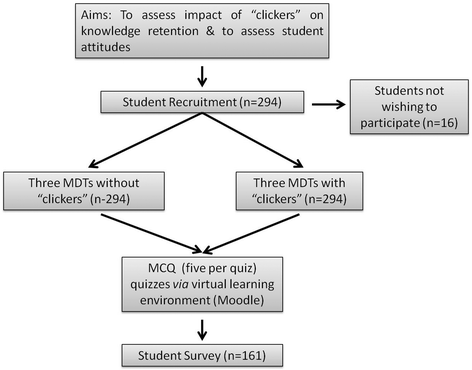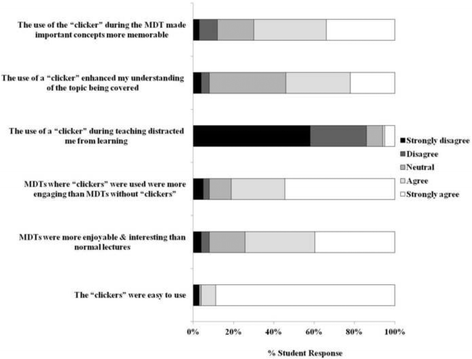A comparative study: do "clickers" increase student engagement in multidisciplinary clinical microbiology teaching?
- PMID: 28390400
- PMCID: PMC5385002
- DOI: 10.1186/s12909-017-0906-3
A comparative study: do "clickers" increase student engagement in multidisciplinary clinical microbiology teaching?
Abstract
Background: Audience response devices, or "clickers", have been used in the education of future healthcare professionals for several years with varying success. They have been reported to improve the learning experience by promoting engagement and knowledge retention. In 2014, our department evaluated the use of "clickers" in a newly introduced multidisciplinary approach to teaching large groups of third year medical students clinical cases developed around a microbiology theme.
Methods: Six multidisciplinary teaching sessions covering community-acquired pneumonia, tuberculosis, infective endocarditis, peritonitis, bloodstream infection with pyelonephritis and bacterial meningitis were included in the study. Three involved the use of the "clickers" and three did not. Consenting undergraduate students attended the designated classes and afterwards answered a short online quiz relating to the session. Students also answered a short questionnaire about the "clickers" to gauge their attitudes on the use of these devices.
Results: Of 310 students, 294 (94.8%) agreed to participate in the study. Interestingly, the grades of online quizzes after a session where a "clicker" was used were slightly lower. Looking only at the grades of students who engaged completely with the process (n = 19), there was no statistical difference to suggest that the devices had a positive or negative impact on knowledge retention. However, student attitudes to using the devices were positive overall. Fifty-five percent strongly agreed and 27% agreed that teaching sessions where the "clickers" were used were more engaging. Thirty-four percent strongly agreed and 36% agreed that the "clickers" made important concepts more memorable and 54% felt the device enhanced their understanding of the topic being covered.
Conclusions: Overall, it appears that "clickers" help in improving student engagement in large classroom environments, enhance the learning experience, and are received positively by medical students but their impact on knowledge retention is variable.
Keywords: Clinical microbiology; Medical education; Multidisciplinary; “Clickers”.
Figures


Similar articles
-
Acceptance of clickers in a large multimodal biochemistry class as determined by student evaluations of teaching: Are they just an annoying distraction for distance students?Biochem Mol Biol Educ. 2016 Jan-Feb;44(1):99-108. doi: 10.1002/bmb.20917. Epub 2015 Oct 30. Biochem Mol Biol Educ. 2016. PMID: 26515808
-
Student evaluation of clickers in a combined dental and dental hygiene periodontology course.J Dent Educ. 2013 Oct;77(10):1321-9. J Dent Educ. 2013. PMID: 24098036
-
Student perceptions of online and in-person microbiology laboratory experiences in undergraduate medical education.Med Educ Online. 2020 Dec;25(1):1710324. doi: 10.1080/10872981.2019.1710324. Med Educ Online. 2020. PMID: 31928152 Free PMC article.
-
Clickers in the large classroom: current research and best-practice tips.CBE Life Sci Educ. 2007 Spring;6(1):9-20. doi: 10.1187/cbe.06-12-0205. CBE Life Sci Educ. 2007. PMID: 17339389 Free PMC article. Review.
-
The impact of clickers in nursing education: a review of literature.Nurse Educ Today. 2011 Nov;31(8):e34-40. doi: 10.1016/j.nedt.2010.12.007. Epub 2011 Jan 13. Nurse Educ Today. 2011. PMID: 21232831 Review.
Cited by
-
Phone-based audience response system as an adjunct in orthodontic teaching of undergraduate dental students: a cross-over randomised controlled trial.BMC Med Educ. 2020 Nov 16;20(1):435. doi: 10.1186/s12909-020-02363-3. BMC Med Educ. 2020. PMID: 33198761 Free PMC article. Clinical Trial.
-
Pros and Cons of Audience Response Systems in the Education of Health Professionals.MedEdPublish (2016). 2019 Sep 24;8:182. doi: 10.15694/mep.2019.000182.1. eCollection 2019. MedEdPublish (2016). 2019. PMID: 38089314 Free PMC article.
-
Using alternative teaching and learning approaches to deliver clinical microbiology during the COVID-19 pandemic.FEMS Microbiol Lett. 2021 Aug 26;368(16):fnab103. doi: 10.1093/femsle/fnab103. FEMS Microbiol Lett. 2021. PMID: 34410390 Free PMC article.
-
Facilitating Active Collaborative Learning in Medical Education; a Literature Review of Peer Instruction Method.Adv Med Educ Pract. 2023 Oct 3;14:1087-1099. doi: 10.2147/AMEP.S421400. eCollection 2023. Adv Med Educ Pract. 2023. PMID: 37810958 Free PMC article. Review.
-
How do they learn: types and characteristics of medical and healthcare student engagement in a simulation-based learning environment.BMC Med Educ. 2021 Aug 6;21(1):420. doi: 10.1186/s12909-021-02858-7. BMC Med Educ. 2021. PMID: 34362346 Free PMC article.
References
-
- Mascolo MF. Beyond student-Centered and teacher-Centered pedagogy: teaching and learning as guided participation. Pedagogy Human Sci. 2009;1(1):3–37.
-
- Young MS, Robinson S, Alberts P. Students pay attention! Act Learn High Educ. 2009;10(1):41–55. doi: 10.1177/1469787408100194. - DOI
-
- McCarthy JP, Anderson L. Active learning techniques versus traditional teaching styles: two experiments from history and political science. Innov High Educ. 2000;24(4):279–294. doi: 10.1023/B:IHIE.0000047415.48495.05. - DOI
-
- Courtier J, Webb EM, Phelps AS, Naeger DM. Assessing the learning potential of an interactive digital game versus an interactive-style didactic lecture: the continued importance of didactic teaching in medical student education. Pediatr Radiol. 2016;46(13):1787–1796. doi: 10.1007/s00247-016-3692-x. - DOI - PubMed
Publication types
MeSH terms
LinkOut - more resources
Full Text Sources
Other Literature Sources

